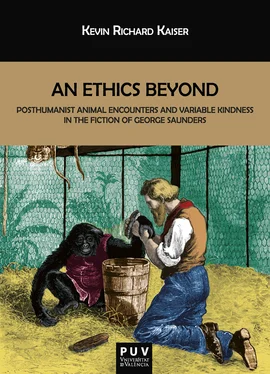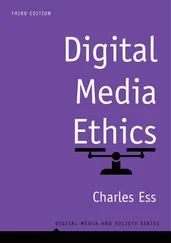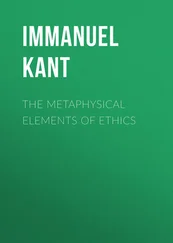Kevin Richard Kaiser - An Ethics Beyond
Здесь есть возможность читать онлайн «Kevin Richard Kaiser - An Ethics Beyond» — ознакомительный отрывок электронной книги совершенно бесплатно, а после прочтения отрывка купить полную версию. В некоторых случаях можно слушать аудио, скачать через торрент в формате fb2 и присутствует краткое содержание. Жанр: unrecognised, на английском языке. Описание произведения, (предисловие) а так же отзывы посетителей доступны на портале библиотеки ЛибКат.
- Название:An Ethics Beyond
- Автор:
- Жанр:
- Год:неизвестен
- ISBN:нет данных
- Рейтинг книги:4 / 5. Голосов: 1
-
Избранное:Добавить в избранное
- Отзывы:
-
Ваша оценка:
- 80
- 1
- 2
- 3
- 4
- 5
An Ethics Beyond: краткое содержание, описание и аннотация
Предлагаем к чтению аннотацию, описание, краткое содержание или предисловие (зависит от того, что написал сам автор книги «An Ethics Beyond»). Если вы не нашли необходимую информацию о книге — напишите в комментариях, мы постараемся отыскать её.
An Ethics Beyond — читать онлайн ознакомительный отрывок
Ниже представлен текст книги, разбитый по страницам. Система сохранения места последней прочитанной страницы, позволяет с удобством читать онлайн бесплатно книгу «An Ethics Beyond», без необходимости каждый раз заново искать на чём Вы остановились. Поставьте закладку, и сможете в любой момент перейти на страницу, на которой закончили чтение.
Интервал:
Закладка:
Closely related to the aforementioned studies is Sarah Pogell’s exploration of hyperreality through a Baudrillardian lens in “‘The Verisimilitude Inspector’: George Saunders as the New Baudrillard?” (2011). For her, Jean Baudrillard’s stages of the sign, most significantly the simulacrum, are exemplified in the writing of Saunders, especially in his stories set in theme parks. Notably, she compares Baudrillard’s explication of the stages of the sign to the “seeming impenetrability” of Derrida’s notion of différance (Pogell 461). Another angle of Saunders’s work is examined in Catherine Garnett’s “The Future in the Pasture: Pastoral Precarity in George Saunders’s ‘Interior Gardens’” (2014). Garnett understands Saunders’s writing as “part of a general trend visible across popular culture that considers pastoral as a representational mode newly relevant to our age” (137). Like Pogell, she emphasizes Saunders’s use of theme parks as settings, noting that Saunders’s writing blurs distinctions: “the otium/negotium divide mystifies the interrelatedness of the terms—the operation of work in the appearance of leisure” (Garnett 139). Beyond pastoral, Saunders’s writing blurs distinctions in many ways, as should become evident in later chapters.
The critical response to Saunders’s writing in terms of socioeconomics, postcolonialism, and postmodernism is not arbitrary. Even if Saunders is not consciously choosing to write stories that are postcolonial or postmodern, such readings of his literature are tuning into what is present in his writing, which in turn is tuned into American culture. His settings, characters, language, and subjects are all rooted in this culture. Conspicuously absent, however, are posthuman readings of his fiction. With the number of approaches toward posthumanism currently being developed and practiced, it is surprising that only one critic has examined Saunders’s fiction through this lens.
Christina Bieber Lake has remarked on certain posthuman elements at play in Saunders’s writing. In Prophets of the Posthuman: American Fiction, Biotechnology, and the Ethics of Personhood (2013), Lake includes a chapter on Saunders and speculative fiction author James Tiptree, Jr. 13In the preface to the book, she argues that
[a]lthough there has been a recognized “turn toward the ethical” already […] the continued misrecognition of reading as an inherently ethical activity has impoverished public debate on questions that reach beyond the traditional domains of literary study. By isolating fiction between the two poles of reading professionally and reading for entertainment, fiction’s potential contribution to the larger ethical debates is marginalized. (xvi)
Lake’s analysis of posthumanism in Saunders’s fiction is concerned primarily with the ethics of biotechnology in a sense that is more appropriately in line with transhumanism, her analysis consisting solely of a reading of “I CAN SPEAK!™.” However, I do agree with some of her more general points, such as the lack of recognition of fiction as a meaningful contributor to ethical discourse.
For Lake, ethical discourse must include careful consideration of narrative. As she notes, one of her primary goals “is to demonstrate that ethical debates—if they are to be meaningful at all—require deep, nuanced, and ongoing reflection on narrative. Narrative does not visit ethical questions abstractly; it lives them, because it lives in the realm of ethos, of persons as persons engaged with one another” (Lake xvii).
The idea that literature “lives” ethical questions is related to my claim that literature allows us to “experience” what can be presented only conceptually by philosophy. In this sense, literature can be ethical. Lake later claims that “literary artists maintain a hope that someone in their audience will see things the way they see them. These writers want individuals to reconsider how they see themselves, others, and life itself. George Saunders is just such a writer” (Lake xviii-xix). Saunders and many other writers not only want to entertain but to affect us.
In an interview for The White Review , Saunders admits that a primary concern “was (and is) not to make trivial work—work that poses too-easy answers to notcritical questions. We’re here, we’re living, loving, but won’t be for long—so I want my stories to somehow urgently acknowledge all of that” (2016, n.p.). Fiction can prod us toward difficult answers to critical questions and help us to be more compassionate. In The Missouri Review interview previously referenced, Saunders states that “the order of the day is compassion” and “that fiction has a part to play in urging us, as a species , toward compassion” (64, italics my own). Based on his own words, Lake is correct to assume, then, that for Saunders, what makes an interesting story is also one with significant ethical stakes.
Another critical reading that is similarly concerned with affect and empathy is the aforementioned Layne Neeper’s “‘To Soften the Heart:’ George Saunders, Postmodern Satire, and Empathy” (2016). Neeper boldly claims that “George Saunders’s postmodern fiction serves as the exemplar for early twenty-first-century American satire’s new attention to affect—to empathy” (282). The essay situates Saunders’s satire as non-traditional, in terms of its literary function. Neeper claims that Saunders’s writing “may still be categorized as satirical” because
the fiction is transactional—readers should feel moved to change, to overcome something —but the sole upshot of Saunders’s satire is to lead to the moral acculturation of empathy in readers, so that we are put in “the proper relation to the truth,” rather than to the inducement to the righting of personal faults or social ills, the avowed aim of the conventional satirist. (287, italics original)
In other words, Saunders’s satire calls on us to empathize. That we may need to right personal faults or social ills is secondary, or, as Neeper puts it, “[p]athos supersedes correction” (296).
One area of criticism that generally has been avoided by critics is the use of nonhuman animals in his fiction, especially in terms of ethics and posthumanist studies. It is this particular gap I aim to fill with the research and analyses I will present in the following chapters. Before settling in to a study of the fiction, however, it is beneficial to have an understanding of the kind of critical theory from which I will draw. For this reason, Chapter 2 provides a survey of posthumanism and posthumanist theory, as the concepts being developed in this area are those I wish to contemplate as we proceed to analyze Saunders’s literature. While the concepts are often difficult to comprehend due to the careful attention to language and frequent use of neologisms, the way these concepts appear in Saunders’s fiction allows for us to analyze how such theories play out in scenarios while also providing a richer appreciation of how his writing functions. Fiction and theory perform complementary roles, especially, in this case, in regards to developing an awareness of ethics. With this understanding of fiction and theory, we may proceed to a survey of posthumanism.
Chapter 2
Beyond Humanism:
Trends in Posthumanist Ethics
“A Potential in Our Culture": The Emergence of Posthumanism
As early as 1976, literary theorist and writer Ihab Hassan speculated in a keynote address delivered at the University of Wisconsin that “the human form—including human desire and all its external representations—may be changing radically, and thus must be re-visioned” (1977, 843). He adds that we must “understand that five hundred years of humanism may be coming to an end, as humanism transforms itself into something that we must helplessly call posthumanism” (Hassan 843). If humanism has not completely come to an end, what we indeed “helplessly” call posthumanism is on the verge of eclipsing it. Certainly, we are amidst a condition we might call posthuman in which the wide-ranging implications present in Hassan’s prediction are too multiple for any one theorist or field to address fully. Published the following year as “Prometheus as Performer: Toward a Posthumanist Culture?”, this address, which reads more like Greek drama, marked the first appearance of the term “posthumanism” in print. Since then, the term has been used extensively in a variety of contexts. Hassan claims that although “posthumanism may appear as a dubious neologism, the latest slogan, or simply another image of man’s recurrent self-hate,” it “may also hint at a potential in our culture, hint at a tendency struggling to become more than a trend,” leading him to pose the crucial question: “How, then, shall we understand posthumanism? (843). The question is still open to debate.
Читать дальшеИнтервал:
Закладка:
Похожие книги на «An Ethics Beyond»
Представляем Вашему вниманию похожие книги на «An Ethics Beyond» списком для выбора. Мы отобрали схожую по названию и смыслу литературу в надежде предоставить читателям больше вариантов отыскать новые, интересные, ещё непрочитанные произведения.
Обсуждение, отзывы о книге «An Ethics Beyond» и просто собственные мнения читателей. Оставьте ваши комментарии, напишите, что Вы думаете о произведении, его смысле или главных героях. Укажите что конкретно понравилось, а что нет, и почему Вы так считаете.












